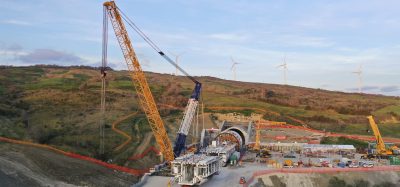The focus is on overcoming barriers and linking Europe
Posted: 1 August 2008 | | No comments yet
With an average yearly investment volume of approximately €1.2 billion in new projects and the development of existing projects, plus approximately €500 million in the existing network, ÖBB-Infrastruktur Bau AG is the force behind track developments in Austria.
With an average yearly investment volume of approximately €1.2 billion in new projects and the development of existing projects, plus approximately €500 million in the existing network, ÖBB-Infrastruktur Bau AG is the force behind track developments in Austria.
With an average yearly investment volume of approximately €1.2 billion in new projects and the development of existing projects, plus approximately €500 million in the existing network, ÖBB-Infrastruktur Bau AG is the force behind track developments in Austria.
Austria – which as a result of the Eastern expansion is now located in the heart of Europe – needs strong railway corridors with optimal connections to its neighbouring states. The focus is on the development of the main connections to high-performance routes and the modernisation of the largest stations. Furthermore, ÖBB makes huge investments in many suburban service projects, enhanced tunnel safety, noise protection measures as well as park & ride facilities and extensive reinvestments in the existing 11,600 kilometres rail network.
Four-track development of the Western line (Danube axis)
ÖBB is currently working at full speed on the four-track development of the 300km long Western railway line between Salzburg and Vienna – the key element of the Austrian section of the TEN 17 railway corridor, i.e. the axis ‘Paris-Strasbourg-Stuttgart-Vienna-Bratislava’.
This development will create the prerequisites for the passenger and goods transport capacity increase urgently needed along this route: now, instead of the former two tracks, a four-track high-performance axis for the West-East traffic is available in prominent sectors.
In the coming years, the investment activities will focus on the areas between Vienna and Linz as well as between Vienna and Bratislava. Long distance travellers and, in particular, the numerous commuters in the Vienna conurbation, will benefit from this new high-performance route. Expected to commence in 2012, the journey time for the route from St. Pölten to Vienna will be reduced from 45 minutes to just under 25 minutes. At the same time, it will be possible to travel from Vienna to Salzburg in 2 hours and 15 minutes. Furthermore, the main stations of Salzburg (under planning) and St. Pölten (under construction) will undergo modernisation.
Vienna-Bratislava
There are currently three projects under planning for the development of the rail connection between the capitals of Vienna and Bratislava (Slovakia). The aim is to create a high-level connection for both passenger and freight transport in accordance with the requirements of the two densely populated areas and with the economic importance of the entire region in the United Europe.
Development of the Southern line (Pontebbana axis) into a high-performance route
With the development of this North-South axis from the Czech Republic via Vienna to Italy, ÖBB is creating a fast and efficient railway line, both safeguarding Austria as a business location and linking the important economic regions in the North and the South of the EU. The two key projects along this axis are the Koralm railway line Graz-Klagenfurt and the new Semmering base tunnel.
Koralm railway line Graz-Klagenfurt
The Koralm railway line will see a two-track electrified route constructed on 130km by 2018, which will directly link the two cities of Graz and Klagenfurt and allow a journey time reduction from currently just less than three hours to approximately one hour. The 33km long Koralm tunnel, at the portals of which two completely new IC stations will be constructed, forms the key element of this line.
New Semmering base tunnel
With approximately 70,000 goods and passenger trains a year, the Semmering – situated between Vienna and Graz – is the most highly frequented mountain route in Austria. The construction of the new Semmering base tunnel as a supplement to the present route is to contribute to a uniformly efficient Southern line and to improve the transport offer in line with the increasing market demands. The key objectives are an end-to-end operation of heavy goods trains with only one locomotive, a considerable journey time reduction for passenger transport as well as the optimisation of the operation and maintenance costs. In preparation of the project, an extensive train path selection procedure was carried out, the results of which have been available since May 2008. Provided that the official procedures such as the environmental impact assessment will be completed by the end of 2011, a realisation will be possible by 2022.
Speedy development of the Lower Inn valley route
The European transport policy on the TEN 1 railway corridor Berlin to Palermo has decided on a gradual procedure concerning the development of the central section between Munich and Verona, the Brenner railway axis. The highest priority will be on the Austrian section between Kundl (region of Wörgl) and Baumkirchen (region of Innsbruck) in the Tyrolean Lower Inn valley. On this two-track route, there is an average operation of approximately 300 trains and on peak days more than 350 trains a day. In terms of operations, an expansion of the rail traffic on the existing facilities is only possible to a certain extent. Thus, the Lower Inn valley has become the bottleneck of the international North-South rail traffic via the Brenner. From a transport policy point of view, the development of this route is a must.
By 2012/13, ÖBB-Infrastruktur Bau AG (commissioned by the Brenner Eisenbahn Gesellschaft, a wholly owned subsidiary of ÖBB-Infrastruktur Bau AG) will construct a new 40km section between Kundl/Radfeld and Baumkirchen. Almost 32km of this route runs through tunnels, sags, underground train paths and one gallery. There are ongoing construction measures in the entire project area. The future high-performance line will allow train operations with speeds of over 200km/h. Apart from the required capacity extension, the new train path will also make it possible to disentangle passenger and goods transport.
The planning of another section; Kundl to Kufstein, is at the ‘path finding’ stage.
Vienna conurbation
The current investment projects in the Vienna conurbation follow two subordinate objectives: the renovation of the Viennese stations and the improvement of Vienna’s connection with the national and international stations.
State-of-the-art stations
In the Vienna conurbation, a total of eight stations are presently undergoing complete modernisation. With the largest project, the new Vienna main station, a traffic hub for 145,000 customers and 1,000 trains a day will be constructed by 2013. This will be the first time in Vienna that the trains from all directions will be connected or continuously linked in one station. Also the stations Vienna West, Vienna Heiligenstadt, Vienna Hütteldorf, Vienna Mitte, Vienna Medling and Airport Vienna Schwechat will be modernised. The station Vienna Praterstern was opened in April in time for Euro 2008.
‘Lainzer Tunnel’
To appropriately connect the Western line with the federal capital Vienna and to also link it with the connecting railway lines in the South and East of Austria, ÖBB-Infrastruktur Bau AG is presently realising the 12.8km long ‘Lainzer’ tunnel for approximately €1.3 billion. This project will allow the underground operation of goods and passenger long distance trains through Vienna; the resulting free capacities above ground can be utilised for the concentrated passenger suburban transport. In addition, major improvements in the noise protection of the bordering residents will be achieved. Its completion is scheduled for the end of 2012.







